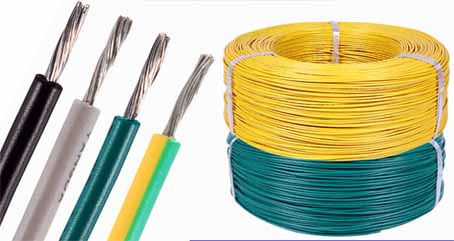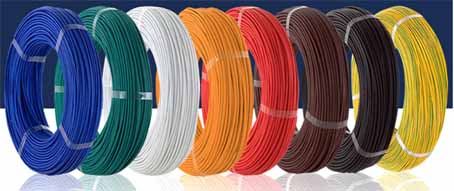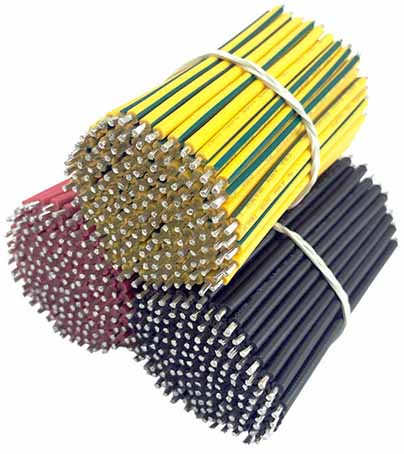Classification and selection of electronic wires

Common electronic wire specifications: PVC electronic wire, irradiation wire, isolation wire, coaxial cable, high temperature wire, flat wave wire, computer cable. Electronic wires generally refer to all internal and external use of electronic equipment or equipment. Electrical connection wires for signal and power transmission;
Its structure can range from a simple general insulated wire to an extremely complex signal transmission cable, covering a very wide range and a wide variety of types.
Voltage --- It is related to the material and thickness of the insulating layer.
Current---related to the size of the conductor.
Temperature---related to the material of the insulating layer.
1. The outer diameter is small.
2. UL and CSA certification are generally required.
3. The conductor needs to be tinned --- to prevent oxidation of the copper wire and easy to solder.
4. The conductor is twisted wire --- good flexibility and easy wiring.
PVC Electronic Wire (Hook Up Wire):
Features: (1). The hardness and gloss can be adjusted according to the formula.
(2). Good acid and alkali resistance.
(3). Excellent flame resistance.
(4). Easy to process and wire.
(5). The price is cheaper.
Main line types: UL1007, 1015, 1032, 1061, 1095, 1617
Purpose: Internal connection line of general electronic equipment.

Irradiation line:
Insulator: XLPVC (80℃, 90℃, 105℃)
XLFRPE(125℃)
Features: 1. The insulation is not easy to shrink during soldering, and the workability is good.
2. Improved mechanical properties, such as crush resistance, wear resistance, cutting resistance, etc.
3. Good acid and alkali resistance and chemical solvent resistance.
4. Improved thermal stability.
5. The price is more expensive.
Main line types: XLPVC: UL1429, 1430, 1431, 1571, 1672
XLFRPE: UL3265, 3266, 3271
Purpose: Internal wiring of electronic appliances and leads of motors, lighting, etc., which require high reliability.
Shielded Wire:
Insulator: PVC, PE, XLPVC, XLPE
Isolation layer: tinned copper wire wound
Cover: PVC
Features: (1) Flexible and easy to wire.
(2) It can isolate signal interference and reduce noise.
Main line types: UL1533, 2547, 1185, 1571, 2851, 2854, 1691, 2791
Purpose: Suitable for all kinds of receiving equipment (audio, radio and tape recorder, walkman, VCR, etc.)
Coaxial Cable:
Insulator: PE, PEF, XLPE, TFE
Isolation layer: copper wire (bare copper wire, tinned copper wire) braided
Cover: PVC, FEP
Features: (1) It can isolate signal interference and reduce noise.
(2) Stable characteristic impedance, excellent high frequency transmission, low attenuation
Main line types: UL1365 (75Ω), 1107 (50Ω).
Uses: TVs, radios, tape recorders, VCRs and other electrical appliances
Internal wiring of the product.

High Temperature Wire:
Insulator: TEFLONTFE (200℃,260℃), TEFLONFEP (150℃,200℃)
Features: (1) Excellent high temperature resistance.
(2) Excellent solder resistance.
(3) Excellent resistance to acids and alkalis, solvents, and oils
(4) Low smoky and non-burning.
(5) Excellent electrical performance, suitable for high-frequency communication, and low attenuation.
(6) The surface is smooth and the color is bright.
(7) The price is high,
Main line types: TFE─UL1180, FEP─UL1330, 1331, 1332, 1333
Uses: electric heaters, generators, motors, electric irons, hair dryers, lighting and other export lines or high-rise fireproof cables.
Flat Cable:
Insulator: PVC
Features: (1) Low occupation rate and easy configuration.
(2) The connector must be connected when wiring, which is easy to disassemble and assemble.
Main line types: UL2468, 2877
Uses: internal wiring of precision instruments and computers.
Computer Cable:
Insulator: PVC, PE, PEF
Isolation layer: aluminum foil Mylar tape, copper wire braid.
Cover: PVC
Features: (1) A wide variety of different uses.
(2) Most parts need to be isolated and shielded to prevent interference
(3) Most of the external wires are used for hue and appearance
The requirements are stricter.
Main line types: UL2464, 2919, 2990
1. Tin plating
2. Stranded wire
3. Insulation extrusion
4. Collection
5. Braided or coiled isolation
6. Being escorted outside
7. High temperature extrusion
8. Irradiation





